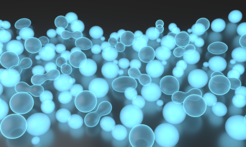Beating Vesicles
Which criteria does a synthetically created cell have to meet to be considered alive? What are the minimal requirements for individual functions of such a cell? Questions like these drive Petra Schwille and her team at the Max Planck Institute for Biochemistry. Now the scientists have shown that it only takes five biological building blocks to generate cell-like structures that exhibit autonomous motion while consuming energy. The discovery of these pulsating, beating vesicles came as a surprise, since initially the scientists wanted to investigate processes related to cell division. The study was published in the journal Angewandte Chemie International Edition.

Artificial cell functions…
Synthetic biology has set itself the task of imitating biological systems, or even modifying them in a way that enables new applications. As such, cell function can be reproduced in the test tube and thus better understood, which may lead to technological advances. The molecular building blocks used are mostly of biological origin, but researchers can either imitate natural mechanisms or pursue new approaches.
...in artificial cell envelopes
Often it is part of synthetic biology to enclose the biological building blocks into microscopically small containers in order to reproduce conditions in living cells. Popular containers are so-called giant vesicles. These bubble-like structures consist of a thin lipid layer that resembles the cell membrane. Additionally, they share other properties, e.g. their size (1-100 µm), with living cells. This makes them an ideal model system in synthetic cell biology.
The scientists at the Max Planck Institute of Biochemistry have now enclosed two different proteins and chemical energy in the form of ATP in the cell-like giant vesicles. Under the microscope, they observed that the structures began to move independently and periodically. In their publication in the journal Angewandte Chemie International Edition, they describe these structures as "beating vesicles".
How does a cell determine its center?
The proteins used for these experiments come from the intestinal bacterium Escherichia coli, which serves as an important model system in biological research. These bacteria have an elongated shape and divide exactly in their center. To figure out where this center is, the rod-shaped bacteria use a sophisticated mechanism: the proteins MinD and MinE oscillate back and forth between the two ends of the bacterium. The cell division machinery is repelled by these proteins and settles as far away as possible from the ends: right in the center of the cell.
Traveling patterns
Now, researchers from the Department of Cellular and Molecular Biophysics at the Max Planck Institute of Biochemistry have succeeded for the first time in encapsulating these oscillating proteins in giant vesicles. The team of Petra Schwille observed that the proteins in the giant vesicles move periodically and oscillate back and forth – similar to the behavior in living bacteria. In future experiments, the researchers plan to enclose further components in the vesicles. This could enable the vesicles to divide and thus multiply. However, the flashing protein patterns were not the only effect the scientists observed under the microscope: Additionally, the vesicles were moving autonomously and rhythmically changing their shape like bouncing rubber balls. Thomas Litschel, first author of the study, explains that the observations came as a surprise, as it was previously not known that a system this simple, built from only a few building blocks, could lead to dynamic membrane deformations of this extent. “Most phenomena in biological systems are much more complex than they seem. Here, finally, the opposite is true: a seemingly complex behavior consisting of very few different biological functional modules”, summarizes Petra Schwille the results.
Although the path to synthetically produced cells is a long one, the reconstitution of individual biological functions adds another item to the biotechnological tool kit required to achieve this goal. Each step along the way to the synthetic cell also improves the understanding of processes in existing organisms. In this way, the “beating vesicles” help the researchers to study the fundamental principles of life.
Original publication:
T. Litschel, B. Ramm, R. Maas, M. Heymann, P. Schwille. „Beating Vesicles: Encapsulated Protein Oscillations Cause Dynamic Membrane Deformations”, Angewandte Chemie International Edition, December 2018
https://doi.org/10.1002/anie.201808750










